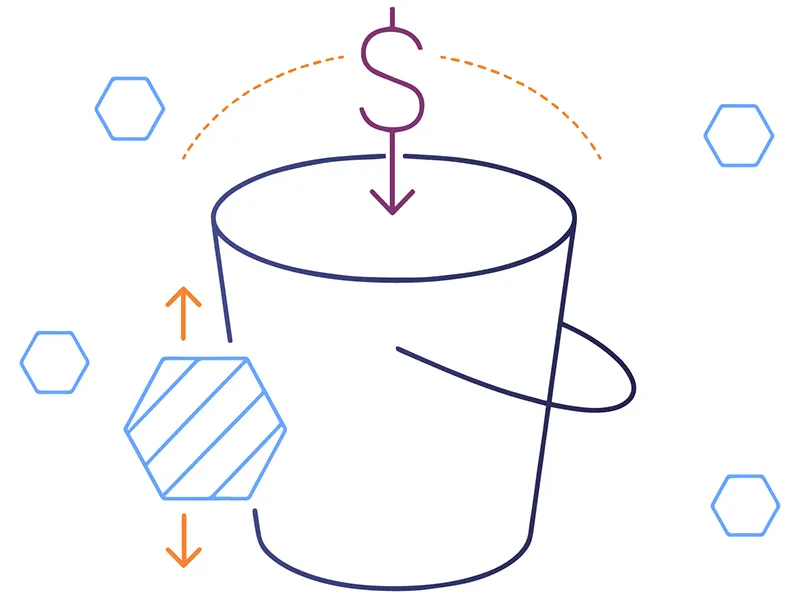La gestión inteligente por niveles de Amazon S3 es una de las maneras más eficaces de reducir los costos de almacenamiento en la nube, especialmente al lidiar con patrones de acceso a datos impredecibles. En Hystax, ayudamos a los equipos de TI a optimizar el gasto en la nube. Esta guía muestra cómo. Niveles inteligentes de Amazon S3 Funciona y cómo utilizarlo eficazmente para reducir costos sin comprometer la disponibilidad ni el rendimiento de los datos.

¿Qué es Amazon S3 Intelligent-Tiering?
Amazon S3 Intelligent Tiering es una clase de almacenamiento que transfiere automáticamente datos entre diferentes niveles de acceso según el uso. Está diseñado para datos con patrones de acceso desconocidos o cambiantes. No necesita predecir la frecuencia con la que se accederá a los datos: S3 lo hace por usted y le cobra según corresponda.
No hay cargos por recuperación y la transición entre niveles se realiza automáticamente en segundo plano. El objetivo es almacenar sus datos de la forma más rentable posible, sin esfuerzo manual.
Niveles de almacenamiento en S3 Intelligent-Tiering
Amazon S3 Intelligent Tiering consta de múltiples niveles de acceso:
- Nivel de acceso frecuente: para datos a los que se accede con frecuencia. Este es el nivel predeterminado al cargar un objeto por primera vez.
- Nivel de acceso poco frecuente: este nivel ofrece un costo de almacenamiento más bajo para los datos a los que no se accede durante 30 días consecutivos.
- Nivel de acceso instantáneo a archivos: este nivel es incluso más económico, pero sigue estando disponible de forma instantánea para los datos a los que no se accede en 90 días.
- Niveles de acceso a archivo opcional y archivo profundo: ofrecen los precios más bajos, pero requieren tiempos de restauración de minutos a horas.
Esta estratificación permite a AWS optimizar los costos de almacenamiento en función de cómo se utilizan los datos a lo largo del tiempo.
Beneficios de usar Intelligent-Tiering
Ahorro de costes
Sin cargos por recuperación
A diferencia de S3 Glacier, Intelligent-Tiering no le cobra por la recuperación de datos.
Optimización automática
AWS supervisa sus datos y los traslada entre niveles sin ningún trabajo manual.
Rendimiento sin interrupciones
Los datos de todos los niveles (excepto los de archivo opcionales) son accesibles instantáneamente y sin demoras en el rendimiento.
¿Quieres ver cuánto puedes ahorrar con Intelligent-Tiering?
¿y otras técnicas de optimización?
Ingrese su correo electrónico comercial para explorar las capacidades de OptScale como plataforma FinOps
¡Gracias por tu solicitud!
Nos pondremos en contacto contigo pronto.
Respetamos su privacidad. Vea nuestra política de privacidadPuedes darte de baja en cualquier momento.

Optimización gratuita de costos de la nube y gestión mejorada de recursos ML/IA de por vida
Cuándo utilizar S3 Intelligent-Tiering

Cómo habilitar S3 Intelligent-Tiering
Puede utilizar Intelligent-Tiering de varias maneras:
1. Configúrelo como predeterminado durante la carga
Al cargar datos en Amazon S3, utilice la consola de AWS, la CLI o la API para elegir Intelligent Tiering como clase de almacenamiento.
2. Utilice políticas de ciclo de vida
¿Ya almacena datos en otras clases? Puede crear reglas de ciclo de vida que transfieran automáticamente los objetos a la estratificación inteligente tras un número determinado de días. Esto es ideal para datos con antigüedad predecible, como registros o exportaciones.
3. Aplicarlo selectivamente
Puede aplicar Intelligent-Tiering solo a categorías, prefijos o etiquetas de objeto específicos para controlar los costos de manera más granular.
Mejores prácticas para maximizar el ahorro
1. Apunta a objetos grandes
AWS no clasifica en niveles archivos menores a 128 KB, por lo que se debe priorizar los archivos grandes para una clasificación inteligente.
2. Supervisar las tarifas de monitoreo
Hay una pequeña tarifa de monitoreo (aproximadamente $0.0025 por cada 1000 objetos al mes). Si almacena muchos objetos pequeños, considere si el ahorro compensa el costo del monitoreo.
3. Combine con la visibilidad de FinOps
Utilice una plataforma de optimización de costos en la nube como Hystax OptScale para rastrear patrones de uso y asegurarse de almacenar datos de manera rentable.
4. Establecer reglas de ciclo de vida con intención
Para los datos de acceso frecuente, evite transiciones innecesarias o traslados de archivos extensos. Ajuste la configuración del ciclo de vida para que se ajuste a las necesidades de datos de su organización.
5. Analizar patrones de acceso
Revise los registros de acceso para comprender la frecuencia con la que se accede a los datos. S3 Storage Lens u OptScale pueden ayudarle con esto.
Consideraciones de costos
Cuando se utiliza correctamente, los ahorros superan con creces los costos de monitoreo adicionales, especialmente para conjuntos de datos con uso desigual.
Casos de uso comunes
- Aplicaciones nativas de la nube con uso de datos variable
- Conjuntos de datos de aprendizaje automático a los que no se accede diariamente
- Los equipos pueden necesitar registros, archivos multimedia y exportaciones en cualquier momento
- Las organizaciones deben retener datos de cumplimiento, aunque rara vez accedan a él
Reflexiones finales
La organización inteligente por niveles de S3 es una forma inteligente y sencilla de reducir los costos de almacenamiento de AWS. Es ideal para empresas que buscan simplificar la gestión del almacenamiento y automatizar la optimización de costos.
En Hystax, ayudamos a las organizaciones Implementar las mejores prácticas de FinOps y obtenga visibilidad completa de sus gastos en la nube. La estratificación inteligente es una de las muchas herramientas que puede aprovechar para tomar decisiones inteligentes sobre almacenamiento.
✅Aumente la eficiencia de AWS S3 con Buscador de objetos duplicados de OptScale—eliminar datos redundantes y reducir costos para un mejor rendimiento →

